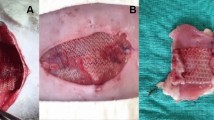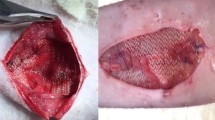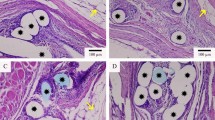Abstract
Purpose
To compare an inflammation score and collagen morphometry after incisional hernia repair with four different meshes at two time points.
Methods
Four types of mesh were used to repair an abdominal wall incisional defect in Wistar rats: high-density polypropylene (HW/PP); low-density polypropylene (LW/PP); polypropylene mesh encapsulated with polydioxanone coated with oxidized cellulose (PP/CE); and expanded polytetrafluoroethylene (ePTFE). An inflammation score based on histological analysis and collagen morphometry was performed after 7 and 28 days after operation (POD).
Results
Compared to LW/PP group at 7 POD, HW/PP group had lower (p = 0.014) and PP/CE group had higher inflammation scores (p = 0.001). At 28 POD, higher scores were seen in all the other groups compared to the LW/PP group (HW/PP, p = 0.046; PP/CE, p < 0.001; ePTFE, p = 0.027). Comparing groups individually at 7 and 28 PODs, all demonstrated lower inflammation score values at 28 POD (HW/PP, p < 0.001; LW/PP, p < 0.001; PP/CE, p = 0.002; ePTFE, p = 0.001). At 7 POD, higher amounts of collagen were detected in ePTFE compared to HW/PP (p < 0.001) and LW/PP (p = 0.004) and in PPCE group compared to HW/PP (p = 0.022). At 28 POD, no statistically significant difference was found. Comparing groups individually at 7 and 28 PODs, HW/PP and LW/PP showed larger amounts of collagen at the 28th POD, without any statistically significant differences for the PP/CE and ePTFE groups.
Conclusions
Inflammation scores decreased in all groups at 28 POD. Collagen deposition was higher for non-composite meshes at 28 POD.








Similar content being viewed by others
References
Williams KB, Belyansky I, Dacey KT, Yurko Y, Augenstein VA, Lincourt AE, Horton J, Kercher KW, Heniford BT (2014) Impact of the establishment of a specialty hernia referral center. Surg Innov 21(6):572–579
DuBay DA, Wang X, Adamson B, Kuzon WM, Dennis RG, Franz MG (2006) Mesh incisional herniorrhaphy increases abdominal wall elastic properties: a mechanism for decreased hernia recurrences in comparison with suture repair. Surgery 140(1):14–24
Akinci M, Yilmaz KB, Kulah B, Seker GE, Ugurlu C, Kulacoglu H (2013) Association of ventral incisional hernias with comorbid diseases. Chirurgia 108(6):807–811
Calvi ENC, Nahas FX, Barbosa MV, Calil JA, Ihara SSM, Juliano Y, Ferreira LM (2014) Collagen fibers in the rectus abdominis muscle of cadavers of different age. Hernia 18(4):527–533
Cassar K, Munro A (2002) Surgical treatment of incisional hernia. Br J Surg 89(5):534–545
Burger JWA, Luijendijk RW, Hop WCJ, Halm JA, Verdaasdonk EGG, Jeekel J (2004) Long-term follow-up of a randomized controlled trial of suture versus mesh repair of incisional hernia. Ann Surg 240(4):578–583 (discussion 583–585)
Goldenberg A, Matone J, Marcondes W, Herbella FAM, Farah JFM (2005) Comparative study of inflammatory response and adhesions formation after fixation of different meshes for inguinal hernia repair in rabbits. Acta Cir Bras 20(5):347–352
Pascual G, Rodríguez M, Sotomayor S, Pérez-Köhler B, Bellón JM (2012) Inflammatory reaction and neotissue maturation in the early host tissue incorporation of polypropylene prostheses. Hernia 16(6):697–707
Klinge U, Klosterhalfen B (2012) Modified classification of surgical meshes for hernia repair based on the analyses of 1,000 explanted meshes. Hernia 16(3):251–258
Klosterhalfen B, Junge K, Klinge U (2005) The lightweight and large porous mesh concept for hernia repair. Expert Rev Med Devices 2(1):103–117
Klinge U, Klosterhalfen B, Birkenhauer V, Junge K, Conze J, Schumpelick V (2002) Impact of polymer pore size on the interface scar formation in a rat model. J Surg Res 103(2):208–214
Harrell AG, Novitsky YW, Cristiano JA, Gersin KS, Norton HJ, Kercher KW, Heniford BT (2007) Prospective histologic evaluation of intra-abdominal prosthetics four months after implantation in a rabbit model. Surg Endosc 21(7):1170–1174
Pereira-lucena CG, Artigiani Neto R, de Rezende DT, Lopes-Filho GJ, Matos D, Linhares MM (2014) Early and late postoperative inflammatory and collagen deposition responses in three different meshes: an experimental study in rats. Hernia 18(4):563–570
Vaz M, Krebs RK, Trindade EN, Trindade MRM (2009) Fibroplasia after polypropylene mesh implantation for abdominal wall hernia repair in rats. Acta Cir Bras 24(1):19–25
Zogbi L, Trindade EN, Trindade MRM (2013) Comparative study of shrinkage, inflammatory response and fibroplasia in heavyweight and lightweight meshes. Hernia 17(6):765–772
Rosch R, Junge K, Knops M, Lynen P, Klinge U, Schumpelick V (2003) Analysis of collagen-interacting proteins in patients with incisional hernias. Langenbecks Arch Surg 387(11–12):427–432
de Noronha L, Chin EWK, Kimura LY, Graf R (2004) Estudo morfométrico e morfológico da cicatrização após uso do laser erbium: YAG em tecidos cutâneos de ratos. J Bras Patol Med Lab 40(1):41–48
Peeters E, De Hertogh G, Junge K, Klinge U, Miserez M (2014) Skin as marker for collagen type I/III ratio in abdominal wall fascia. Hernia 18(4):519–525
Rosch R, Junge K, Quester R, Klinge U, Klosterhalfen B, Schumpelick V (2003) Vypro II® mesh in hernia repair: impact of polyglactin on long-term incorporation in rats. Eur Surg Res 35(5):445–450
Junge K, Rosch R, Krones CJ, Klinge U, Mertens PR, Lynen P, Schumpelick V, Klosterhalfen B (2005) Influence of polyglecaprone 25 (Monocryl) supplementation on the biocompatibility of a polypropylene mesh for hernia repair. Hernia 9(3):212–217
Author information
Authors and Affiliations
Corresponding author
Ethics declarations
Conflict of interest
CTM declares no conflict of interest. RAN declares no conflict of interest. GJLF declares no conflict of interest. MML declares no conflict of interest.
Statement of human and animal rights
All procedures performed in studies involving animals were in accordance with the ethical standards of the institution or practice at which the studies were conducted. This article does not contain any studies with human participants performed by any of the authors.
Informed consent
No informed consent.
Rights and permissions
About this article
Cite this article
Maeda, C.T., Artigani Neto, R., Lopes-Filho, G.J. et al. Experimental study of inflammatory response and collagen morphometry with different types of meshes. Hernia 20, 859–867 (2016). https://doi.org/10.1007/s10029-016-1513-7
Received:
Accepted:
Published:
Issue Date:
DOI: https://doi.org/10.1007/s10029-016-1513-7




